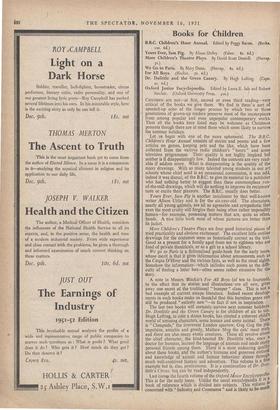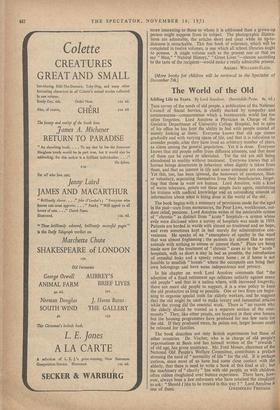Books for Children
Yours Ever, Sam Pig. By Alison Uttley. (Faber. 8s. 6d.) More Children's Theatre Plays. By David Scott Daniell. (Harrap.
Cs-) We Go to Paris. By Mary Dunn. (Harrap. 8s. 6d.) Dr. Dolittle and the Green Canary. By Hugh Lofting. (Cape. 9s. 6d.) Oxford Junior Encyclopaedia. Edited by Laura E. Salt and Robert Sinclair. (Oxford University Press. 3os.)
CHILDREN are not—at first, second or even third reading—very critical of the books we give them. We find in them' a sort of speeded-up echo of the longer process by which two or three generations of grown-up readers preserve most of the masterpieces from among popular and even unpopular contemporary works. Thus all the books here listed may be welcome as Christmas presents though there are at most three which seem likely to survive the summer holidays.
Let us begin with one of the more ephemeral. The B.B.C. Children's Hour Annual consists of stories and poems and a few articles on games, keeping pets and the like, which have been collected from the various radio children's " hours " and some television programmes. Their quality is not highly inspired but neither is it disappointingly low. Indeed the contents are very read- able if seldom more. What is disappointing is the quality of the many drawings. With so many talented young students in our art schools whose chief need is an occasional commission, it was odd, indeed it was dismal, of the B.B.C. to give its material to a publisher who had nothing better to suggest than these commonplace run- of-the-mill drawings, which will do nothing to improve its recipients' taste or excite their pleasure. The B.B.C. usually does better.
Yours Ever, Sam Pig is another instalment by that well-known writer Alison Uttley and is for the six-year-old. The characters, nearly all young animals, are all so agreeable ad sympathetic that even the most crusty will forgive their being often rather impossibly human—for example, possessing trotters that are, quite as often, hands. A nice little book most of whose pictures are better than its jacket.
More Children's Theatre Plays are four good historical pieces of tried practicality and obvious excitement. The excellent little outline drawings for the costumes seem as historically correct as the text. Good as a present for a family aged from ten to eighteen who are fond of private theatricals, or as a gift to a school library. We go to Paris is a fictionalised guide-book for the early teens, whose merit is that it gives information about amusements such as the Cirque D'Hiver and the various fairs, as well as the usual sights. Somehow the information—which includes such points as the diffi- culty of finding a letter box—often seems rather excessive for the story.
A note in Messrs. Blackie's For All Boys (of ten to fourteen), to the effect that its stories and illustrations • are all new, gives away one secret of the traditional " bumper " class. This is not bad example of current escape literature. Indeed recent develop- ments in such books make us thankful that this harmless genre can still be produced "entirely new "—in fact if not in inspiration. The last two books will certainly survive next summer holidaYs• Dr. Doolittle and the Green Canary is for children of six to ten. Hugh Lofting, in over a dozen books, has created a coherent child's world of amusing characters, some human and some animal. There is " Cheapside," the irreverent London sparrow, Gug Gug the Pig, impulsive, amiable and greedy, Mathew Mug the cats' meat man, and there are also many exotic creatures. These all revolve about the chief character, the kind-hearted Dr. Doolittle who, once doctor for humans, learned the language of animals and made mall personal friends among them. There is a most endearing quality about these books, and the author's humane and generous outlott and knowledge of animal . and human behaviour shines through much well-contrived fantasy and adventure. This volume is a fioe example but is, alas, posthumous. It is a continuation of Dr. Doc' little's Circus, but can be read independently. Last comqs the fourth volume of the Oxford .1 inior Encykopgediaa. This is for the early teens. Unlike the usual encyclopaedia it IS , book of reference which is divided into subjects. This volume 1,! concerned with "Industry and Commerce" and is likely to be mucu
more interesting to those to whom it is addressed than a grown-up person might suppose from its subject. The photographic illustra- tions are admirable, the articles short and clear while its up-to- dateness is remarkable. This fine book of reference, which will be completed in twelve volumes, is one which all school libraries ought to possess. A single volume such as the present one or that on say " Man," "Natural History," "Great Lives "—chosen according to the taste of the recipient—would make a really admirable present.
AMABEL WILLIAMS-ELLIS.
[More books for children will be reviewed in the Spectator of December 7th.]















































































 Previous page
Previous page